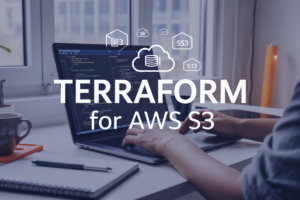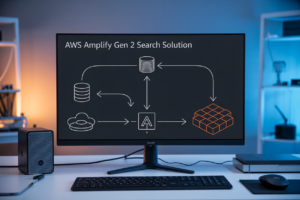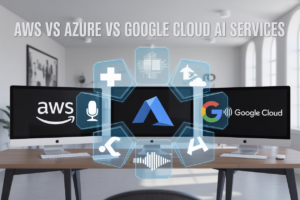Running large language models in production requires a robust infrastructure that can handle massive computational demands while staying cost-effective. This guide walks you through building a vLLM inference platform on Amazon ECS with EC2 compute, giving you the power to deploy and scale containerized LLM inference workloads efficiently.
This tutorial is designed for DevOps engineers, ML engineers, and cloud architects who need to deploy high-performance language models in production environments. You’ll learn practical steps to set up reliable inference infrastructure that can handle real-world traffic demands.
We’ll cover the essential components of Amazon ECS deployment architecture and how it optimizes vLLM performance compared to traditional deployment methods. You’ll also discover hands-on techniques for EC2 infrastructure setup and vLLM Docker containerization, including the specific configurations needed to maximize throughput and minimize latency. Finally, we’ll dive into ECS service management strategies that ensure your large language model deployment AWS infrastructure remains stable and scalable as your usage grows.
Understanding vLLM and Its Performance Advantages
What is vLLM and how it accelerates large language model inference
vLLM stands as a high-performance inference engine specifically designed to accelerate large language model serving. Unlike traditional serving frameworks that often struggle with memory bottlenecks and sequential processing limitations, vLLM implements innovative techniques like PagedAttention to dramatically improve GPU memory utilization. This specialized architecture allows organizations to serve powerful language models with significantly reduced latency while maximizing throughput, making it an ideal choice for production deployments requiring both speed and reliability.
Key benefits over traditional inference frameworks
The advantages of vLLM over conventional inference solutions become apparent when examining real-world performance metrics. Traditional frameworks often waste precious GPU memory through inefficient attention mechanisms, while vLLM’s PagedAttention reduces memory waste by up to 4x compared to standard implementations. This efficiency translates to higher concurrent user support, lower operational costs, and faster response times. Organizations migrating from legacy inference systems typically observe 2-5x throughput improvements without requiring additional hardware investments.
Memory optimization techniques and throughput improvements
vLLM’s memory optimization centers around its revolutionary PagedAttention algorithm, which treats attention computation like virtual memory management in operating systems. This approach eliminates the need for contiguous memory allocation, reducing fragmentation and enabling dynamic batching of requests with varying sequence lengths. The system also implements continuous batching, processing new requests immediately rather than waiting for entire batches to complete. These optimizations result in substantially higher GPU utilization rates and enable serving larger models on existing hardware configurations.
Supported model architectures and scaling capabilities
The platform supports a comprehensive range of popular model architectures including GPT, LLaMA, Mistral, CodeLlama, and many Hugging Face transformers models. vLLM handles models ranging from 7B to 175B+ parameters, with built-in support for quantization techniques like AWQ and GPTQ for further memory optimization. Scaling capabilities extend from single-GPU deployments to multi-GPU and multi-node configurations, making it suitable for everything from development environments to large-scale production systems requiring high availability and massive throughput capacity.
Amazon ECS Architecture for vLLM Deployment
ECS Service and Task Definition Fundamentals
Amazon ECS provides the foundation for running containerized vLLM inference platforms through two core components: services and task definitions. Task definitions act as blueprints that specify container configurations, resource requirements, and networking settings for your vLLM applications. Services manage the deployment and scaling of these tasks, maintaining desired instance counts and handling health checks. For vLLM inference workloads, task definitions must include GPU resource allocation, memory specifications, and environment variables for model loading. ECS services automatically replace failed tasks and distribute traffic across healthy instances, creating a robust inference platform that can handle production workloads seamlessly.
Container Orchestration Benefits for ML Workloads
Container orchestration transforms how machine learning teams deploy and manage vLLM inference platforms. ECS automatically handles container placement, resource allocation, and failure recovery across your EC2 fleet. This eliminates manual intervention when instances fail or when you need to scale capacity. Rolling deployments allow you to update vLLM models without downtime, while service discovery enables seamless communication between components. Load balancing distributes inference requests efficiently across multiple containers, maximizing throughput. Auto Scaling policies respond to demand changes by launching or terminating containers based on metrics like CPU usage or request queue depth, ensuring optimal resource usage while maintaining performance.
Integration with EC2 Compute Instances for Optimal Performance
EC2 compute instances provide the raw computational power needed for high-performance vLLM inference, while ECS orchestrates containers across this infrastructure. GPU-enabled instance types like P4d or G5 offer the memory bandwidth and parallel processing capabilities that large language models require. ECS placement strategies can target specific instance types or availability zones based on your performance requirements. Container resource reservations ensure vLLM workloads get dedicated GPU memory and CPU cores. Instance draining allows graceful maintenance without dropping active inference requests. This integration creates a scalable platform where containers automatically migrate between healthy instances, maintaining service availability while delivering consistent inference performance across your entire deployment.
Setting Up Your EC2 Infrastructure
Selecting the right EC2 instance types for GPU acceleration
Picking the perfect EC2 instance for your vLLM inference platform comes down to matching your model size with GPU memory capacity. P4d instances with A100 GPUs offer 40GB HBM2 memory, making them ideal for large language models requiring substantial VRAM. For smaller models, G5 instances with NVIDIA A10G GPUs provide cost-effective performance with 24GB memory. P3 instances remain viable for older workloads, while the newer P5 instances deliver cutting-edge performance for enterprise deployments. Consider your throughput requirements – larger instances support higher concurrent requests but cost more per hour.
Configuring security groups and networking requirements
Your EC2 infrastructure setup needs precise security group configuration to balance accessibility with protection. Create inbound rules allowing port 8000 for vLLM API endpoints, SSH access on port 22 for management, and HTTP/HTTPS traffic for load balancer communication. Configure outbound rules permitting Docker Hub access for container pulls and ECR connectivity for private repositories. Set up VPC endpoints for S3 and ECR to reduce data transfer costs and improve security. Network ACLs should complement security groups, providing additional protection layers. Enable VPC Flow Logs to monitor traffic patterns and detect anomalous behavior across your containerized LLM inference environment.
Installing Docker and ECS agent on EC2 instances
Start by launching Amazon Linux 2 AMIs optimized for ECS, which come pre-configured with Docker and the ECS agent. For custom AMIs, install Docker using the package manager and configure it to start automatically. Download the ECS agent container and set it to restart on boot. Create the ECS configuration file specifying your cluster name and region. The agent registers your EC2 instances with your ECS cluster automatically. Verify installation by checking Docker daemon status and confirming ECS agent connectivity. Update both components regularly to maintain compatibility with AWS container orchestration LLM features and security patches.
Setting up IAM roles and permissions for secure access
Design IAM roles following the principle of least privilege for your vLLM deployment. Create an EC2 instance role with policies for ECS task execution, ECR image pulling, and CloudWatch logging. The ECS task role needs permissions for S3 model storage access, parameter store configuration retrieval, and any external API calls your inference service makes. Attach the AmazonECSTaskExecutionRolePolicy to your task execution role, then add custom policies for ECR and CloudWatch access. Your EC2 instances need the AmazonEC2ContainerServiceforEC2Role policy to communicate with ECS services. Use AWS Systems Manager for secure parameter storage instead of embedding credentials in container images.
Containerizing vLLM Applications
Creating optimized Docker images with vLLM dependencies
Building an efficient vLLM Docker container requires careful attention to base image selection and dependency management. Start with NVIDIA’s CUDA runtime images as your foundation, then install PyTorch with CUDA support matching your target EC2 instance GPU drivers. Layer your Docker image strategically by installing system dependencies first, followed by Python packages, and finally vLLM itself. This approach optimizes build caching and reduces image size. Consider using multi-stage builds to separate build dependencies from runtime requirements, keeping your final image lean while maintaining all necessary components for optimal vLLM inference performance on Amazon ECS.
Managing model artifacts and storage configurations
Model storage strategy directly impacts your vLLM inference platform’s startup time and scalability. Store large language models on Amazon EFS for shared access across ECS tasks, or use S3 with local caching for cost-effective distribution. Configure your containers to download models during startup or pre-bake them into custom AMIs for faster deployment. Mount model directories as volumes in your ECS task definitions, ensuring read-only access for security. Implement model versioning through S3 object keys or EFS directory structures, allowing seamless model updates without service downtime while maintaining consistent performance across your containerized LLM infrastructure.
Environment variable setup for runtime parameters
Runtime configuration through environment variables provides flexibility for your vLLM deployment without rebuilding containers. Define key parameters like model paths, tensor parallel size, GPU memory utilization, and API server settings through ECS task definition environment variables. Create parameter hierarchies using AWS Systems Manager Parameter Store or AWS Secrets Manager for sensitive configurations. Set CUDA_VISIBLE_DEVICES to control GPU allocation, configure memory limits through VLLM_GPU_MEMORY_UTILIZATION, and specify model loading parameters. This approach enables dynamic scaling and configuration management across different environments while maintaining security best practices for your Amazon ECS vLLM inference platform.
Resource allocation and GPU access configuration
Proper GPU resource allocation ensures maximum performance from your EC2 compute infrastructure. Configure ECS task definitions with GPU requirements using the gpuRequirements parameter, specifying GPU count and type for optimal vLLM performance. Set memory and CPU limits based on your model size and expected throughput requirements. Enable GPU sharing across containers when running smaller models, or dedicate entire GPUs for large language model inference. Configure NVIDIA Container Runtime in your ECS cluster to provide GPU access to containerized applications. Monitor GPU utilization through CloudWatch custom metrics to optimize resource allocation and ensure cost-effective deployment of your vLLM inference platform on Amazon ECS.
Deploying and Managing ECS Services
Creating ECS clusters and registering EC2 instances
Start by creating your ECS cluster through the AWS console or CLI, selecting EC2 launch type for maximum control over your vLLM inference platform. Register your GPU-enabled EC2 instances by installing the ECS agent and configuring the cluster name in /etc/ecs/ecs.config. Your instances will automatically appear in the cluster dashboard, ready for task deployment. Verify connectivity by checking the ECS agent logs and confirming instance registration status shows as “ACTIVE” in your cluster overview.
Defining task definitions with proper resource constraints
Configure your vLLM task definitions with precise CPU and memory allocations, typically 4-8 vCPUs and 16-32GB RAM per inference container. Set GPU requirements using resourceRequirements with type “GPU” and specify the number of GPUs needed for your model size. Define environment variables for model paths, tensor parallelism settings, and API endpoints. Include health checks with custom endpoints like /health to ensure proper container startup. Map container ports correctly, usually 8000 for vLLM’s default FastAPI server, and set restart policies to “always” for production reliability.
Implementing auto-scaling policies for dynamic workloads
Create CloudWatch alarms based on CPU utilization, memory usage, and custom metrics like request queue depth for your containerized LLM inference workloads. Set up ECS service auto-scaling with target tracking policies, scaling out when CPU exceeds 70% and scaling in when it drops below 40%. Configure minimum and maximum task counts based on your traffic patterns – start with 2 minimum tasks for high availability and set maximum limits to control costs. Use step scaling for rapid traffic spikes, adding 2-3 tasks when request latency exceeds acceptable thresholds.
Setting up load balancing for high availability
Deploy an Application Load Balancer to distribute inference requests across your vLLM ECS service tasks, ensuring even workload distribution and fault tolerance. Configure target groups with health check paths pointing to your vLLM health endpoint, setting appropriate timeout and interval values. Enable sticky sessions if your application requires request continuity, though stateless vLLM inference typically doesn’t need this. Set up multiple availability zones for your ECS service management and load balancer to prevent single points of failure, achieving true high availability for your AWS container orchestration LLM deployment.
Performance Optimization and Monitoring
Fine-tuning vLLM parameters for maximum throughput
Optimizing your vLLM inference platform requires careful attention to key parameters that directly impact performance. Start by adjusting the max_model_len parameter to match your specific use case – shorter sequences allow for higher concurrent requests. The tensor_parallel_size should align with your GPU count, while max_num_seqs controls batch processing efficiency. Enable continuous batching with --enable-chunked-prefill to maximize throughput. Set gpu_memory_utilization to 0.85-0.95 for optimal memory allocation without causing out-of-memory errors. Configure max_num_batched_tokens based on your GPU memory capacity, typically starting with 2048 and scaling up. The quantization parameter can reduce memory usage when using INT8 or INT4 models. Monitor these settings through load testing to find the sweet spot between latency and throughput for your specific workload patterns.
Implementing CloudWatch monitoring and custom metrics
CloudWatch integration provides deep visibility into your vLLM performance optimization efforts across your ECS cluster. Configure custom metrics to track tokens per second, request latency percentiles, and GPU utilization rates through the CloudWatch agent. Set up alarms for critical thresholds like memory usage above 90% or response times exceeding your SLA requirements. Create custom dashboards displaying real-time inference metrics, including queue depth and concurrent request counts. Use CloudWatch Logs Insights to analyze request patterns and identify bottlenecks. Implement application-level metrics using the CloudWatch SDK to capture vLLM-specific data like cache hit rates and model loading times. Configure auto-scaling policies based on custom metrics such as average queue wait time or GPU memory utilization. This comprehensive monitoring approach enables proactive performance tuning and ensures your containerized LLM inference maintains optimal performance under varying loads.
Cost optimization strategies for EC2 and ECS resources
Smart cost management for your vLLM deployment starts with choosing the right EC2 instance types for your workload characteristics. Use GPU-optimized instances like G5 or P4 series, but consider Spot instances for non-critical workloads to achieve up to 70% cost savings. Implement ECS service auto-scaling based on demand patterns to avoid over-provisioning resources during low-traffic periods. Schedule non-urgent inference jobs during off-peak hours using ECS scheduled tasks. Right-size your containers by monitoring actual resource consumption and adjusting CPU and memory reservations accordingly. Use Reserved Instances for predictable baseline capacity while leveraging On-Demand instances for peak loads. Configure ECS capacity providers to mix Spot and On-Demand instances automatically. Monitor costs through AWS Cost Explorer and set up budget alerts for your ECS service management. Consider using AWS Savings Plans for additional discounts on consistent compute usage patterns across your large language model deployment AWS infrastructure.
Setting up a vLLM inference platform on Amazon ECS with EC2 gives you a powerful combination of performance and flexibility. You get vLLM’s lightning-fast inference speeds paired with ECS’s container orchestration capabilities, all running on EC2 instances you can customize to your heart’s content. The containerized approach makes scaling and managing your AI workloads much simpler, while the monitoring and optimization techniques help you squeeze every bit of performance out of your setup.
Ready to build your own high-performance AI inference platform? Start with a small proof-of-concept deployment using the architecture and steps outlined above. Begin with basic container configurations, get your ECS services running smoothly, then gradually add performance optimizations and monitoring as your needs grow. The beauty of this setup is that you can start simple and scale up as your AI workloads demand more power and sophistication.




















